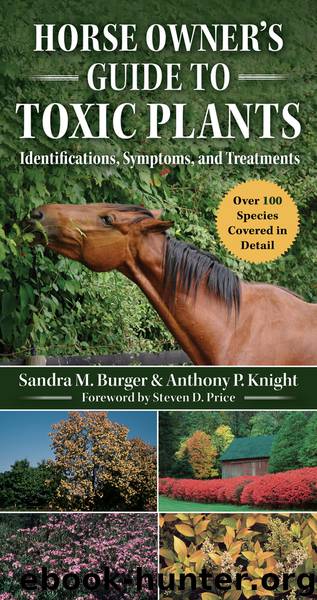Horse Owner's Guide to Toxic Plants by Sandra McQuinn

Author:Sandra McQuinn
Language: eng
Format: epub
ISBN: 9781510741676
Publisher: Skyhorse
Published: 2020-06-03T16:00:00+00:00
Geographic Distribution
Southwestern Canada, south to Minnesota, South Dakota, Texas, and beyond; prairies and sandy soil, especially in arid and mountainous areas of the West.
Signs of Poisoning
Poisoning usually occurs in late winter or early spring, and symptoms may take several months to appear. Weight loss and abnormal behavior are typical of locoweed poisoning. Horses develop unpredictable behavior, including falling over and charging through fences. Affected horses should not be ridden.
What to Do
There is no effective treatment for locoweed poisoning and death will occur if the animal is not removed from the source. But once clinical signs of locoism are apparent, horses rarely recover completely even if removed from the locoweeds. A “locoed” horse should be given a poor prognosis as there will always be a risk to someone riding that horse. Pregnant mares eating woolly locoweed may produce foals with crooked legs. Prevention of locoweed consumption may be accomplished by holding animals out of locoweed areas until other forages are abundant, and by selective use of appropriate herbicides.
Download
This site does not store any files on its server. We only index and link to content provided by other sites. Please contact the content providers to delete copyright contents if any and email us, we'll remove relevant links or contents immediately.
| Birds | Cats |
| Dogs | Essays |
| Fish & Aquariums | Food & Nutrition |
| Horses | Insects & Spiders |
| Mice, Hamsters & Guinea Pigs | Pet Loss |
| Rabbits | Reptiles & Amphibians |
Finding Gobi by Dion Leonard(2277)
Grumpy Cat by Grumpy Cat(2146)
The Silkworm by Robert Galbraith(2026)
A New Earth: Awakening to Your Life's Purpose by Eckhart Tolle(1992)
End of Days by Sylvia Browne(1833)
Tippi by Tippi Hedren(1783)
Total Cat Mojo by Jackson Galaxy(1696)
Backyard Chickens Beyond the Basics by Pam Freeman(1623)
The Animals Among Us by John Bradshaw(1514)
The Ultimate Pet Health Guide by Gary Richter(1440)
Vet in Harness by James Herriot(1395)
Cesar's Way by Cesar Millan(1375)
Dog Years by Mark Doty(1371)
Doggy Desserts: 125 Homemade Treats for Happy, Healthy Dogs by Cheryl Gianfrancesco(1368)
All Things Bright and Beautiful by James Herriot(1316)
Chicken Soup for the Ocean Lover's Soul by Jack Canfield(1302)
Walking with Peety by Eric O'Grey(1293)
Dog Training 101 by Kyra Sundance(1277)
Encyclopedia of Dog Breeds by D. Caroline Coile Ph.D(1188)
